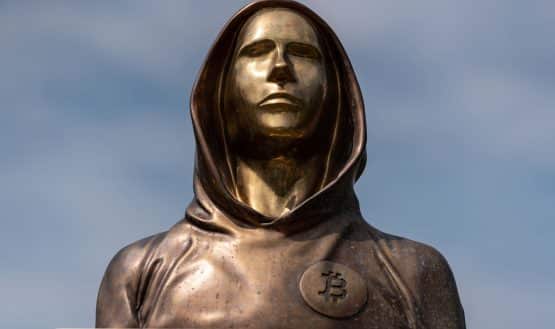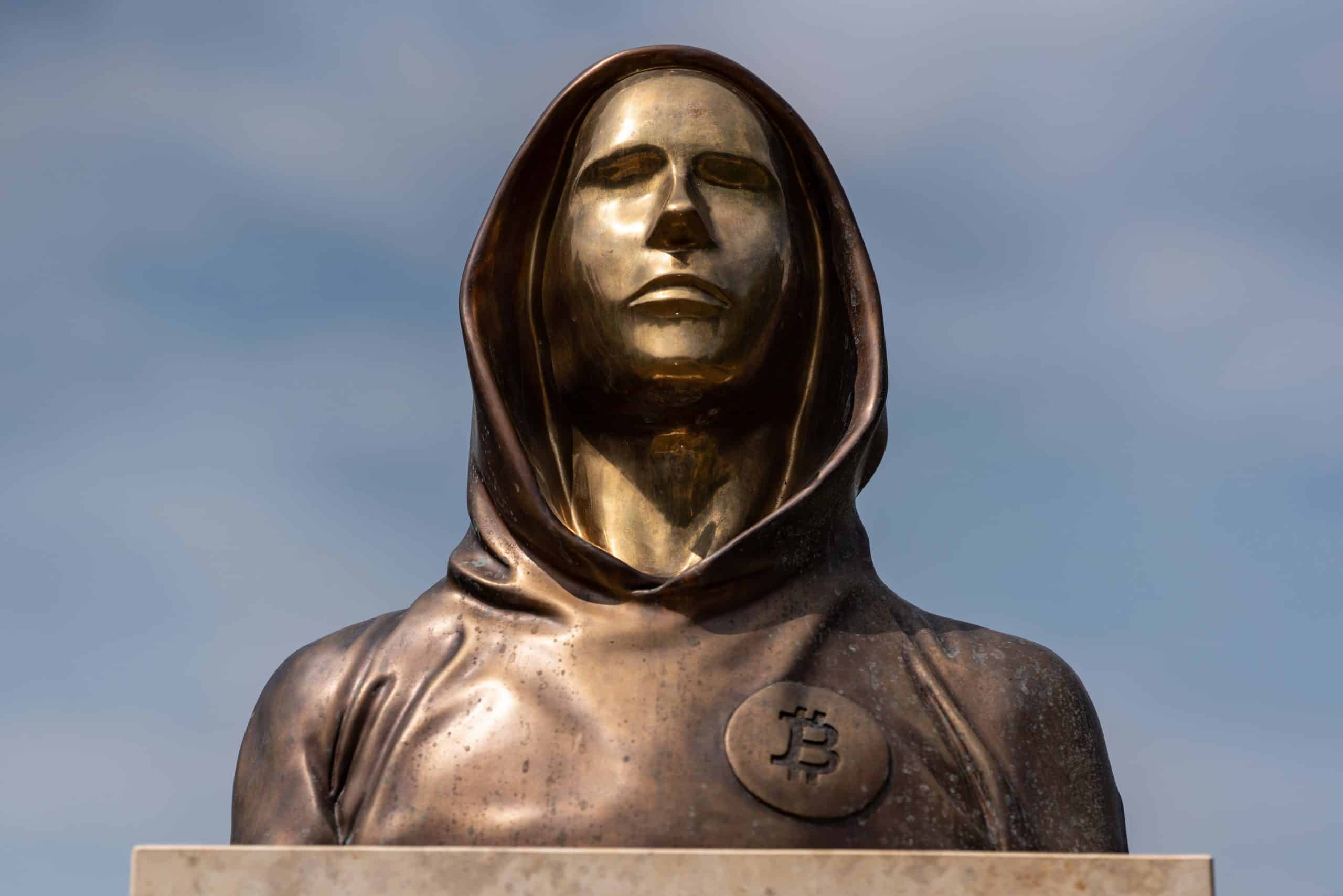The true identity of Satoshi Nakamoto, the pseudonymous creator of Bitcoin, is one of the biggest mysteries in the history of blockchain technology and modern tech in general.
With just a nine-page whitepaper, Satoshi Nakamoto set off a monetary revolution that has evolved into a $2 trillion industry. Since Bitcoin’s launch in 2009, cryptocurrencies have disrupted global financial markets and enabled entirely new industries like decentralized finance (DeFi) and NFTs. And yet, the creator behind it all has never revealed their identity. There are no photos, interviews, or confirmed sightings of the infamous creator. Nakamoto appeared, invented Bitcoin, and disappeared without claiming credit or fame.
Despite the endless theories of who invented Bitcoin, no one has been able to prove who Satoshi Nakamoto really is, at least not yet. The name lives on in crypto culture, courtrooms, and research papers.
So, who, or what, is Satoshi Nakamoto? What do we know for sure? And how much Bitcoin does Nakamoto still control? Let’s take a closer look.
Key Takeaways
- Satoshi Nakamoto published the Bitcoin whitepaper in 2008 and launched the network in 2009, but their real identity remains unknown.
- After communicating with early developers and building the foundation of Bitcoin, Satoshi gradually stepped back and stopped posting, leaving others to carry the project forward.
- Satoshi is believed to hold over 1 million BTC. These coins have never been moved.
Who Is Satoshi Nakamoto?
Satoshi Nakamoto published the Bitcoin whitepaper on October 31, 2008. The paper introduced a revolutionary idea: a revolutionary peer-to-peer electronic cash system that removed the need for financial institutions to act as intermediaries.
In early 2009, Bitcoin’s inventor mined the Genesis block, famously known as Block 0. Nakamoto then officially launched the Bitcoin network and created the first 50 bitcoins, hiding a message in the block:
“The Times 03/Jan/2009 Chancellor on brink of second bailout for banks.”
The message was a reference to a UK newspaper headline and, according to many, a comment on the failures of the traditional financial system. Some sleuths suggest that the UK headline may indicate that Nakamoto is from the UK, and this is backed up by his use of some British spellings, though this hasn’t been confirmed.
Between January 2009 and December 2010, Nakamoto worked on Bitcoin’s early code, corresponded with other developers working on the project, and helped fix bugs in it. In this period, Nakamoto engaged with others about the technicalities of Bitcoin and its network, commenting on forums that discussed the topic. His insights were often technical, addressing issues like the double-spend problem or transaction propagation. One such comment was shared on BitcoinTalk in 2010:
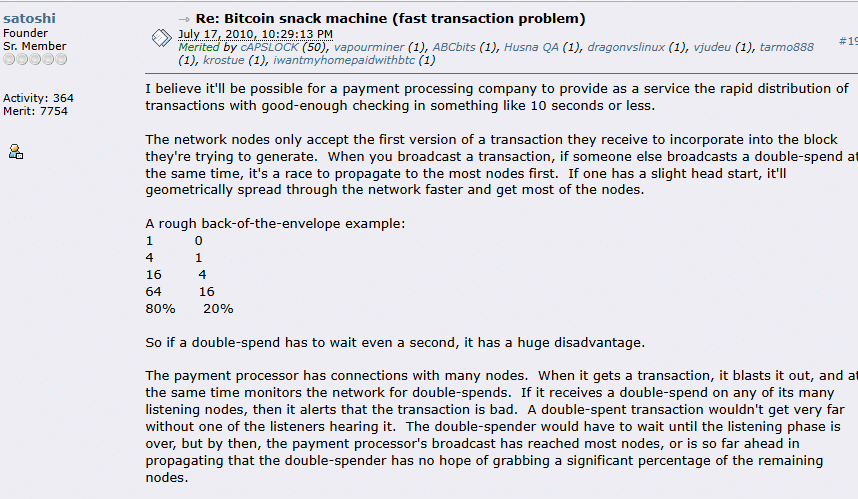
Nakamoto was quite active on the forums for a few years but, by December 2010, they handed over control of the code repository and completely vanished from public view. The last verified message of Bitcoin’s creator came in April 2011 in an email they sent to a developer, saying: “I’ve moved on to other things”.

Since then, Satoshi Nakamoto’s identity has never been confirmed. Some suspect Nakamoto is a single genius behind the Bitcoin blockchain. Others believe they are a group of coders and cryptographers who collaborated anonymously.
Nakamoto’s Bitcoin Holdings
One of the most intriguing aspects of the mysterious case of Satoshi Nakamoto is the fortune that was left behind. Researchers estimate that Nakamoto mined nearly 1 million Bitcoin in the early days. His coins seem to have never been spent or moved. At today’s prices, they are worth over $65 billion, which would make Satoshi Nakamoto one of the richest people worldwide.
Furthermore, blockchain analysts have identified several wallets believed to be associated with the pseudonym Satoshi Nakamoto. The most notable is the genesis address (the first-ever Bitcoin address), which received a reward of 50 BTC for mining the first Bitcoin block, known as the Genesis block. The address currently holds around 100 BTC.
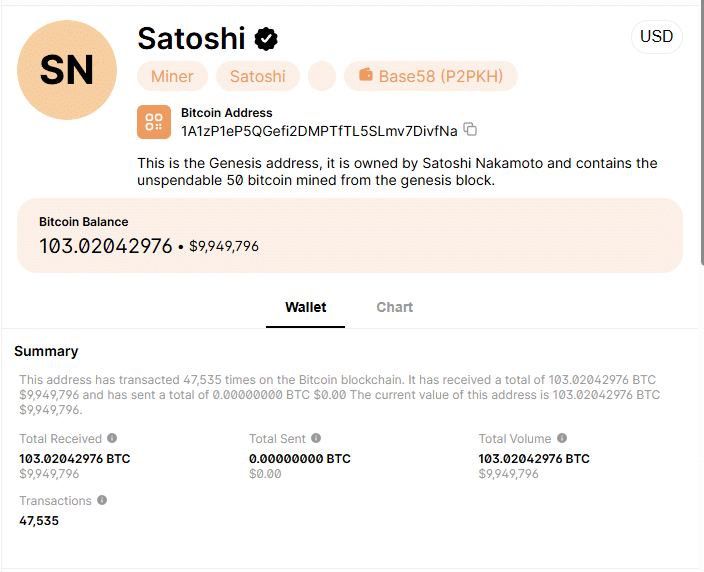
Is Craig Wright Satoshi Nakamoto?
Craig Wright, an Australian academic and computer scientist, has been one of the most vocal individuals claiming to be Satoshi Nakamoto. Wright’s timeline of public claims dates back to 2016 when he first asserted that he was Nakamoto. From that point onward, Wright has made numerous controversial statements, but his claims have been met with criticism and skepticism from the crypto community.
Vitalik Buterin, the co-founder of Ethereum and an important thought-leader in the crypto sphere, weighed in on Wright’s claims. Buterin was vocal in his belief that Wright is not Nakamoto, often citing the inconsistencies in Wright’s claims, his lacking technical knowledge, and his failure to provide concrete proof. Buterin spoke about Wright in an episode of the Lex Fridman podcast if you want to hear more.
In 2016, Craig Wright presented a series of cryptographic proofs to support his claims that he is, in fact, Satoshi Nakamoto. However, soon after he shared these, experts started pointing out inconsistencies. He claimed to have signed messages using Nakamoto’s private keys, but the signatures were later proven to be fabricated.
In 2019, Wright was involved in a major legal battle against the estate of his former business partner, Dave Kleiman. Wright’s constant claims of being Nakamoto came under scrutiny in court, and he was accused of fabricating evidence.
In 2024, Wright was sentenced to a one-year suspended prison term after the High Court in London found him in contempt of court for repeatedly suing people and falsely claiming to be Satoshi Nakamoto. Despite previously being ordered to stop legal actions against Bitcoin developers, he continued his lawsuits, attempting to claim intellectual property rights related to Bitcoin.
Wright was also found to have falsified documents related to his possession of Nakamoto’s Bitcoin wallet. He was ordered to pay £145,000 in court costs.
“In both his written evidence and in days of oral evidence under cross-examination, I am entirely satisfied that Dr Wright lied to the court extensively and repeatedly. Most of his lies related to the documents he had forged, which purported to support his claim. All his lies and forged documents were in support of his biggest lie: his claim to be Satoshi Nakamoto,” said Judge Mr. Justice Mellor.
In the following video by Bitcoin Magazine, take a closer look at the details of the legal battle where the self-proclaimed Nakamoto, Craig Wright, faced accusations of fraud:
If you want to learn more about Wright’s false claims, check out lawyer Tristan Sherliker’s talk from Bitcoin Amsterdam below, where he breaks down the entire saga.
Is Elon Musk Satoshi Nakamoto?
Some have speculated that Elon Musk, the CEO of Tesla and SpaceX, could be Satoshi Nakamoto. This is largely due to Musk’s involvement in the tech space, claims made by some of his employees, and his cryptic tweets.
The theory gained traction when an intern who worked at SpaceX, Sahil Gupta, made a case for Musk’s involvement based on similarities between Musk’s writing and Nakamoto’s early work (as well as some remarks from Musk’s staff). Gupta was convinced that Musk was Nakamoto.
However, this theory is widely regarded as a highly unlikely one for several reasons.
First, Elon Musk has quashed the rumor by responding to a post on X:
Not true. A friend sent me part of a BTC a few years, but I don’t know where it is.
— Elon Musk (@elonmusk) November 28, 2017
His Twitter history shows that Musk has shown more interest in promoting other cryptocurrencies, such as Dogecoin, rather than Bitcoin. While Musk has expressed admiration for Bitcoin and blockchain technology in general, there is no evidence to support the idea that he is Nakamoto.
In 2022, he also explicitly denied the allegations in the Lex Fridman podcast:
When asked about his opinion, Musk says:
“I don’t know exactly, obviously, who created Bitcoin for practical purposes, but the evolution of ideas is pretty clear for that. It seems as though Nick Szabo, more than anyone else, is probably responsible for the evolution of those ideas. He claims not to be Nakamoto, but I’m not sure that’s important. He seems to be the one more responsible for the ideas behind Bitcoin than anyone else.”
More importantly, the timeline doesn’t add up. Satoshi Nakamoto was active in the creation of Bitcoin in the mid-2000s. Musk’s first major involvement in cryptocurrency came in the late 2010s.
Is Hal Finney Satoshi Nakamoto?
Hal Finney was a prominent cryptographer and an important early Bitcoin contributor. He is frequently mentioned in discussions in the Bitcoin community, and many think that he is Nakamoto himself. Finney was one of the first people to receive Bitcoin from Nakamoto, specifically in the Genesis block. He was deeply involved with Bitcoin development and early testing as well. Satoshi’s disappearance also roughly coincided with Finney’s retirement, which followed his diagnosis of multiple sclerosis, further fueling the rumors.
Still, despite the arguments in favor of Finney being Satoshi Nakamoto, there is one significant argument against it: his public denial. Finney repeatedly shared that he was not Satoshi Nakamoto before his passing in 2014. However, most of the community’s leading candidates believed to be Satoshi have also publicly denied the claim.
Finney’s interview with Wired in 2011 is one of the most public accounts where he expressed his ideas about Bitcoin and the identity of Satoshi Nakamoto. In the interview, Finney discussed his involvement in the development of Bitcoin, but he explicitly denied being Nakamoto.
Finney also had private email exchanges with Nakamoto, which were made public through various Bitcoin archives. He exchanged technical ideas and offered feedback on the Bitcoin software.
“When Satoshi announced the first release of the software, I grabbed it right away. I think I was the first person besides Satoshi to run Bitcoin. I mined block 70-something, and I was the recipient of the first bitcoin transaction, when Satoshi sent ten coins to me as a test. I carried on an email conversation with Satoshi over the next few days, mostly me reporting bugs and him fixing them. Today, Satoshi’s true identity has become a mystery.”, Finney wrote in his 2013 story published by the Satoshi Nakamoto Institute.
He confirmed that he is not Satoshi Nakamoto, but also that he has no idea who the Bitcoin creator is:
“But at the time, I thought I was dealing with a young man of Japanese ancestry who was very smart and sincere. I’ve had the good fortune to know many brilliant people throughout my life, so I recognize the signs.”
Is Nick Szabo Satoshi Nakamoto?
Nick Szabo is another name frequently linked to Nakamoto. Szabo is a well-known cryptographer and the wealthy creator of Bit Gold, a digital currency concept that predated and likely inspired Bitcoin. His work on Bit Gold laid the foundation for many of the principles of Bitcoin, which led many to believe that Szabo is actually Nakamoto.
In 2005, Szabo proposed Bit Gold, a system designed to create a digital currency that required users to solve cryptographic puzzles to mine coins, much like how Bitcoin’s blockchain functions.
Curiously, even after developing the idea for over seven years, he never released his project. What’s most puzzling is that the blog post in question was later made to appear as though it was published after Bitcoin’s release.
Even more intriguing is Szabo’s total lack of public interaction with Nakamoto, unlike other early crypto pioneers like Finney and Gavin Andresen, both of whom corresponded with Bitcoin’s mysterious creator many times.
In addition to this, many people point to similarities between the writing styles of Szabo and Satoshi Nakamoto. The vocabulary, tone, and style used in the Bitcoin whitepaper and early forum posts resemble Szabo’s writings, including the ones about smart contracts and cryptographic principles.
The most compelling clue is what some consider a Freudian slip. In a 2017 interview with Tim Ferriss, Nick Szabo accidentally said, “When I designed Bitcoin,” before quickly correcting himself. You can listen to the full interview here:
Still, the evidence is circumstantial, and Szabo has since publicly and explicitly denied being Nakamoto. “I am not Satoshi,” he told Nathaniel Popper, a reporter for The New York Times.
Is Adam Back Satoshi Nakamoto?
Adam Back is a British cryptographer and a cypherpunk, renowned for inventing the proof-of-work system cited in the Bitcoin whitepaper, Hashcash. He is also the co-founder and CEO of Blockstream, one of the leading companies building infrastructure for Bitcoin and supporting its long-term development.
Back’s development of Hashcash in the late 1990s laid the foundational work for Bitcoin’s proof-of-work mechanism. Nakamoto referenced Back’s Hashcash in the original whitepaper, indicating respect for his work. In addition to this, Back was an active member of the cypherpunk mailing list, a group instrumental in discussions where Bitcoin was first introduced.
There have been email exchanges between Back and Nakamoto, showing direct communication during the early development of the blockchain.
Despite the claims, Back has consistently denied being Satoshi Nakamoto. In a 2020 interview with Decrypt, he stated: “Just that people speculate, but I’m not Satoshi.”
some claim to be Satoshi, days google research blogging stories, and in court, to widespread non-belief.
seems I need the opposite: I am not Satoshi despite recent video / reddit claiming so. some factors & timing may look suspicious in hindsight; coincidence & facts are untidy.
— Adam Back (@adam3us) May 11, 2020
The existence of email correspondence between Back and Nakamoto also suggests they were separate individuals, though it is certainly possible that they were faked.
Other Popular Candidates for Satoshi Nakamoto
Over the years, several other people have been linked to Satoshi Nakamoto’s true identity. Still, Satoshi’s identity remains one of the most intriguing mysteries in the tech world. Here is an overview of some other prominent figures who have been speculated to be Nakamoto:
Peter Todd
Peter Todd is a Canadian cryptographer and a notable Bitcoin developer. In 2024, the HBO documentary Money Electric: The Bitcoin Mystery posited Todd as Nakamoto. However, Todd denied these claims, expressing concerns over the dangers of such allegations. In an email to CoinDesk, Todd responded:
“Of course, I’m not Satoshi. It’s ironic that a director who is also known for a documentary on QAnon has resorted to QAnon-style coincidence-based conspiracy thinking here, too.”
In October 2024, he also shared, “We are not going to find Satoshi” on his X account:
“The level of reaching here rivals QAnon stuff (which is pretty ironic if you know what Cullen's previous documentary was about)”
Exactly.
The truth is pretty simple: there's hundreds, even thousands of people who could have created Bitcoin.
We're not going to find Satoshi. https://t.co/TZMtqJhxgU
— Peter Todd (@peterktodd) October 9, 2024
Dorian Nakamoto
In 2014, Newsweek identified Dorian Nakamoto, a Japanese-American engineer, as Bitcoin’s creator. The article highlighted his name and background in engineering. The claim seems to be mostly based on his last name, and while it was a popular theory for a short time, it has since fallen by the wayside. Dorian Nakamoto has consistently denied being Bitcoin’s founder.
Interestingly, Dorian Nakamoto and Hal Finney lived in the same town: Temple City, California. This led to speculation that Finney was actually Nakamoto and may have drawn inspiration from the name.
Gavin Andresen
Gavin Andresen is an American software developer who became heavily invested in Bitcoin in its early days. He was one of the first developers to work closely with Bitcoin’s source code and was trusted by Nakamoto to take over the development of Bitcoin after Nakamoto’s disappearance.
This handover is of particular interest to the Bitcoin community since Nakamoto had been communicating with Andresen more directly than with anyone else. He communicated with him about key technical details and improvements in terms of Bitcoin’s software.
Still, Andresen has consistently claimed that he never knew Nakamoto’s true identity. In a 2014 blog post, he went so far as to speculate about Nakamoto’s possible identity.
In 2016, Andresen publicly supported Craig Wright’s claim to be Nakamoto, stating that he had met Wright in London in 2011, where Wright allegedly demonstrated proof of his identity by signing a message using the private key from Bitcoin’s first block. He stated that he was “convinced beyond a reasonable doubt” that Wright was Nakamoto.
However, in the aftermath of Wright’s claims and legal troubles, Andresen faced criticism within the Bitcoin community, which led to the revocation of his commit access to the Bitcoin Core repository. Reflecting on this, Andresen has expressed regret for his involvement in the debate.
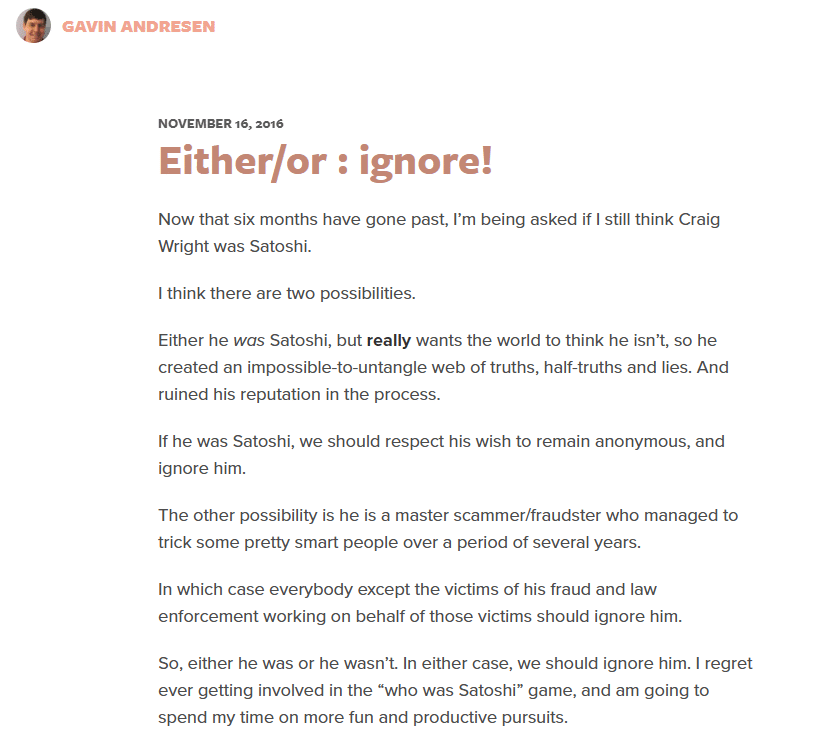
Benjamin Wallace
Benjamin Wallace is a journalist known for his in-depth exploration of Satoshi’s identity. His 2011 article “The Rise and Fall of Bitcoin” was one of the first major investigations into Nakamoto’s creation of Bitcoin.
More recently, his book “The Mysterious Mr. Nakamoto” delves deeper into the story of the secret, reclusive genius. Still, while some mention that he might be Nakamoto, there is no credible evidence to prove this. In fact, Wallace has always approached Bitcoin as a reporter trying to uncover Nakamoto’s identity.
Who Is Satoshi Nakamoto: Key Takeaways
The invention of Bitcoin sparked a global movement, laying the foundation for the entire crypto industry and fundamentally altering how we think about money, decentralization, and trust. But the identity of the person or entities who started it all remain shrouded in secrecy. Despite countless investigations, theories, and claims, Satoshi Nakamoto’s identity is still unknown.
Over the years, hundreds of individuals have been named as possible candidates, some willingly, others not so much, but definitive proof has always been out of reach, and the question may never be solved. It is nothing short of remarkable that such an influential figure, who sparked a multi-trillion-dollar industry with a single whitepaper, has remained anonymous.
Will we ever discover the true identity of Satoshi Nakamoto? They certainly went to great lengths to hide their identity, using secure email accounts, VPNs, and never revealing personal details. Unless they choose to step forward willingly, or someone presents indisputable cryptographic proof (like signing a message from one of Satoshi’s wallets), their identity may remain one of the internet’s greatest mysteries. And as with everything else related to Bitcoin, it will be so by design.
FAQ
Why did Satoshi Nakamoto disappear?
Satoshi's disappearance remains a mystery. He gradually stepped back from Bitcoin's development around 2010.
Is Satoshi Nakamoto still alive?
It is unclear whether Nakamoto is still alive, or even if this pseudonym is an individual or a group of people. No communication has been made since his last email in 2011.
What happened to Satoshi Nakamoto's Bitcoin?
Nakamoto is believed to have mined around 1 million bitcoins in the early days, but they remain untouched in the original wallet.
References
- Satoshi Nakamoto’s blog posts – BitcoinTalk.org
- What Is the Double Spend Problem? – Investopedia
- How Much Bitcoin Did Satoshi Mine in 2009? – Binance Square blog
- Man Who Falsely Claimed to Be Bitcoin Creator Sentenced – The Guardian
- Hal Finney’s final blog post – Nakamoto Institute
- The Face Behind Bitcoin – Newsweek
